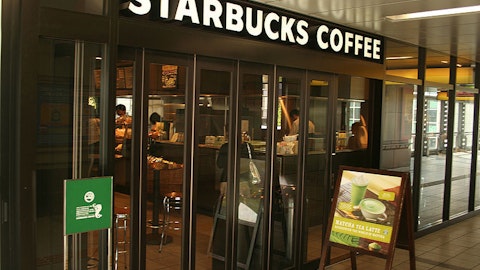Wedgewood Partners, an investment management firm, published its first quarter 2021 investor letter – a copy of which can be downloaded here. A return of +4.8% was reported by the fund for the Q1 of 2021, outperforming its Russell 1000 Growth benchmark that delivered a 1% return, but below both the S&P 500 and Russell 1000 Value Index that had a 6.2% and 11.3% gains in the same period. You can view the fund’s top 5 holdings to have a peek at their top bets for 2021.
Wedgewood Partners, in their Q1 2021 investor letter, mentioned Starbucks Corporation (NASDAQ: SBUX) and shared their insights on the company. Starbucks Corporation is a Seattle, Washington-based coffeehouse and roastery reserve that currently has a $135.5 billion market capitalization. Since the beginning of the year, SBUX delivered a 7.65% return, extending its 12-month gains to 56.66%. As of April 14, 2021, the stock closed at $115.16 per share.
Here is what Wedgewood Partners has to say about Starbucks Corporation in their Q1 2021 investor letter:
“As we have observed Starbucks through the unpredictable events of the past year, we believe all the things we liked about the Company’s competitive position before the pandemic have been turbocharged by the pandemic. We always have maintained the Company had no serious competition, anyway, and that in both large growth markets (U.S. and China), there was enormous fragmentation of share that would allow the Company to continue to expand through market expansion (especially in China) and through share gain versus small competitors. In fact, when we last discussed Starbucks, there was a lot of noise about competition in China from a newly established domestic competitor, Luckin Coffee, and that situation quickly dissolved into farce. In any case, had Luckin been a legitimate business, we had maintained that China was a massive market – and one in which coffee consumption was massively underpenetrated in comparison to other markets. We believed too that there was plenty of room for multiple large competitors to exploit.
The pandemic disaster over the past year truly highlights the Company’s financial strength in comparison to its small competitors, most of which struggled to survive, and many of which didn’t make it. While there is no perfect data, we have seen estimates from industry groups and restaurant distributors that as many as 15-20% of small, independent restaurants across the broad food and beverage industry may have closed permanently as a result of the pandemic, sadly. Starbucks not only survived due to its superior financial position; they also used its financial resources to invest in a variety of expanded or new capabilities, including the addition of drive-through capacity, new “walk-through” pick-up locations in urban areas, increased investment in technology to drive speed within the stores and drive-through lanes, and expansion of its loyalty program. These could have been viewed, prior to the pandemic, as a fairly big advantage in terms of convenience alone versus the Company’s small primary competitors. In the age of the pandemic, though, one might consider something like a drive-through an absolute necessity, as customers choose not to expose themselves to the interior of restaurants or to other people.
Another sign of the Company’s superior financial strength has been the continued expansion of the store base, even in the face of the pandemic. As of the end of the Company’s last fiscal year, September 2020, Starbucks had opened +4% more stores, including +13% growth in China. Additionally, Starbucks not only opened stores as competing stores folded; the Company is seeing more attractive lease terms on new stores (and on existing stores, for that matter), meaning that a store opening program that already had generated attractive financial returns will now generate even more attractive returns.
Short-term results, of course, have been quite poor all over the world, with some portion of the Company’s locations closed or operating on reduced hours for the last several quarters. Customers are simply reticent to show up even when stores have been open. We expect shorter-term results to remain unpredictable, as they will be tied to the ebb and flow of various COVID-related lockdowns around the world. However, Starbucks said it expected sales at established locations in both the U.S. and China to rebound to pre-pandemic levels in the March quarter that just ended. In addition, despite reduced operating hours still, and despite customers’ work and school routines being completely disrupted, a surprisingly early development in comparison to what we, at least, expected only a few quarters ago, is proof of the Company’s entrenched position in its customers’ lives. In contrast, the National Restaurant Association in the U.S. recently predicted that 2021 industry sales would recover significantly versus 2020, but would still come in nearly (-15%) below 2019 levels.
On the Company’s most recent Analyst Day in December 2020, management took its longerterm expectations a bit higher, primarily driven by a modest expected improvement in sales versus its prior expectations. Considering smaller competitors went belly-up and the Company’s investments in enhanced capabilities further improved its competitive position, we believe this improvement in longer-term sales trends is a layup. We also believe the technological investments and the improved terms from landlords create obvious benefits for to an already attractive margin and return profile. Our bullishness on the Company has not wavered and, in fact, we feel better than we did about the Company’s business model over the next several years than we did when we bought the stock originally.”

Our calculations show that Starbucks Corporation (NASDAQ: SBUX) does not belong in our list of the 30 Most Popular Stocks Among Hedge Funds. As of the end of the fourth quarter of 2020, Starbucks Corporation (NASDAQ: SBUX) was in 67 hedge fund portfolios, compared to 66 funds in the third quarter. SBUX delivered a 13.10% return in the past 3 months.
The top 10 stocks among hedge funds returned 231.2% between 2015 and 2020, and outperformed the S&P 500 Index ETFs by more than 126 percentage points. We know it sounds unbelievable. You have been dismissing our articles about top hedge fund stocks mostly because you were fed biased information by other media outlets about hedge funds’ poor performance. You could have doubled the size of your nest egg by investing in the top hedge fund stocks instead of dumb S&P 500 ETFs. Here you can watch our video about the top 5 hedge fund stocks right now. All of these stocks had positive returns in 2020.
At Insider Monkey, we scour multiple sources to uncover the next great investment idea. For example, Federal Reserve has been creating trillions of dollars electronically to keep the interest rates near zero. We believe this will lead to inflation and boost real estate prices. So, we recommended this real estate stock to our monthly premium newsletter subscribers. We go through lists like the 15 best innovative stocks to buy to pick the next Tesla that will deliver a 10x return. Even though we recommend positions in only a tiny fraction of the companies we analyze, we check out as many stocks as we can. We read hedge fund investor letters and listen to stock pitches at hedge fund conferences. You can subscribe to our free daily newsletter on our website:
Disclosure: None. This article is originally published at Insider Monkey.





